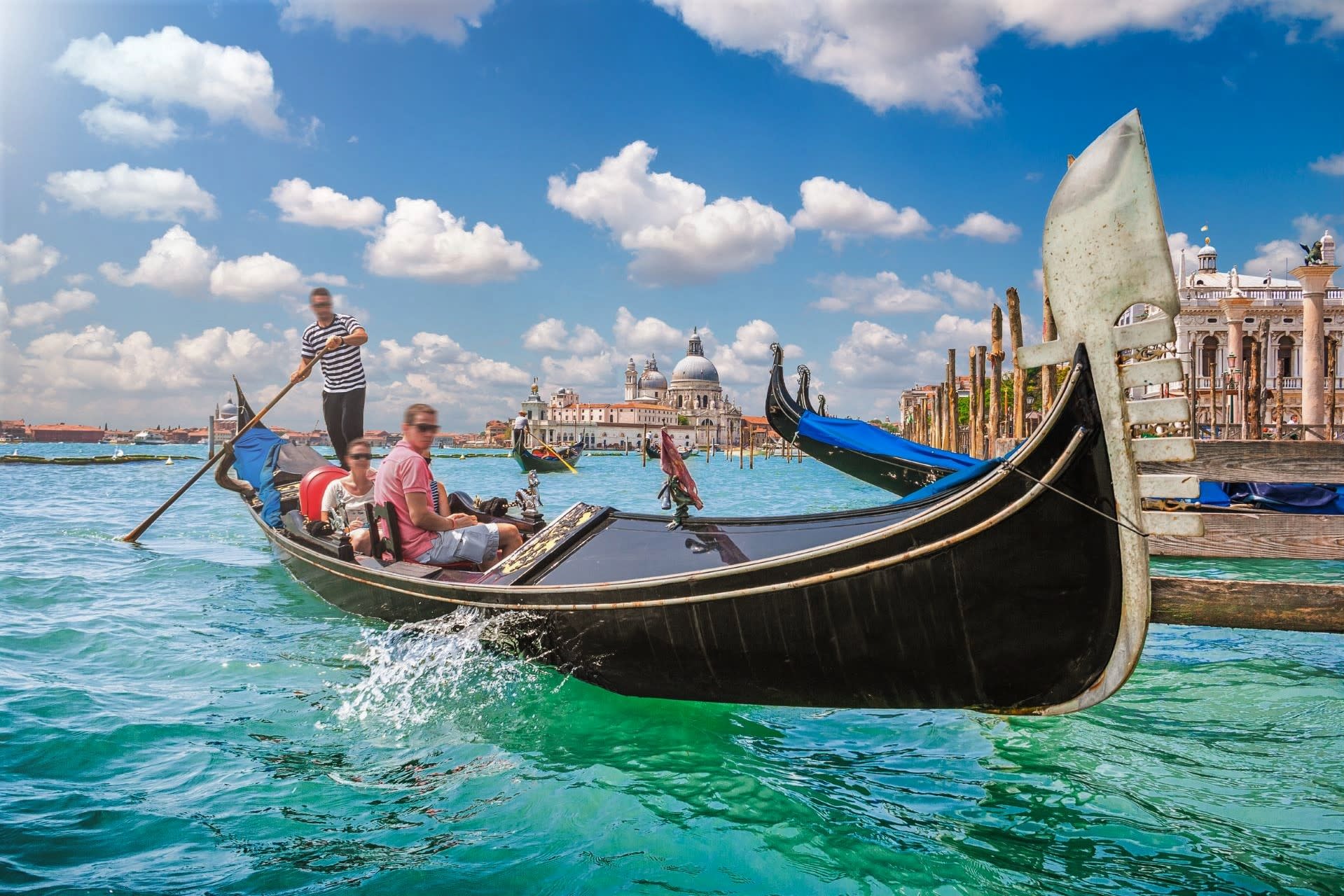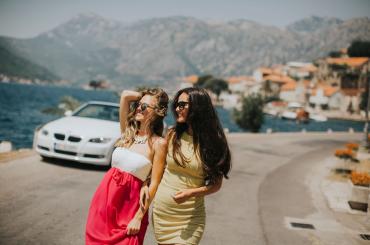
Tour Croatia+ trip
Step into the world of spectacular destinations, ancient ruins, wonderful museums, soaring mountains and beautiful natural scenery of three inspiring European destinations Italy, Slovenia and Croatia.
Extremely versatile trip designer with an established career in travel business
Fill out a few details and get a detailed itinerary with all inclusions and trip details - we can customize them together
It’s difficult to describe Venice in a word or two. It is absorbing, romantic and most definitely unique, mostly because people don't just live overlooking the water, it’s a mix of unrepeatable feelings, views, sounds, reflections and colours that create the essence of the city.
Slovenia is rich in mountains, meadows, lakes, caves, and the sea. Its natural beauty is invaluable and it constantly ranks among the most attractive and friendly countries in Europe.
Croatia stands for perfectly preserved medieval cities, incredible food, dreamy landscapes, friendly people, picturesque red-roof houses, crystal blue waters of the Adriatic Sea and has the highest number of UNESCO Intangible Goods of any European Country.
Visit the famous Juliet’s House and contemplate the ill-fated love affair of Romeo and Juliet
You are about to discover the handpicked highlights of Italy, Slovenia and Croatia. Here you can learn a few interesting facts about some of them.
Italy
Italy has been, since antiquity, the centre of history, culture and art. Our museums, collections and archaeological sites reveal countless tokens of the past and the many civilizations that have passed across this country, evidence of which is still inextricably woven into the present-day landscape.
Its proper name Repubblica Italiana (Italian Republic), Nickname: “Bel Paese” which means beautiful country. Rome its capital city was founded in 753BC. Artistic wonders can be found everywhere, and every corner of the country holds countless and wonderful surprises. Our artistic and cultural heritage is one of the most valuable in the world.
Italy has more cultural UNESCO World Heritage Sites than any other country. The whole country can boast towns of breathtaking beauty, as these numbers demonstrate: 95,000 monumental churches, 40,000 forts and castles, 30,000 historical residences with 4,000 gardens, 36,000 archives and libraries, 20,000 historical cities and towns, 5,600 museums and archaeological sites, and 1,500 convents.
Venice
Venice is dubbed as one of the most romantic cities in the world and it is easy to see why when you walk through its many narrow cobbled streets and canals. Located in the Venetian lagoon, Venice is an island city that is formed from hundreds of individual islands all joined together by a network of canals and bridges. The central Grand Canal is a magnificent sight and the buildings that line it look simply beautiful. Furthermore, St. Mark’s Square is an absolute must-see with the opulent cathedral, the immense bell tower and the flocks of pigeons. Don’t forget to visit the Rialto Bridge, the Bridge of Sighs and Doges Palace too.
Verona
Verona, the UNESCO World Heritage Site and it’s surviving architecture and urban structure reflects the evolution of this fortified town over its 2,000-year history. Visit the famous Juliet’s House, see Juliet's balcony, where -it's said- she looked out to see her lover Romeo and relive the magic story of the two star-crossed lovers.
Spend some time at your pace to make some shopping, taste the famous "Juliet's braid", a typical dessert of Verona, or sip a glass of Valpolicella, a wonderful red wine coming from the famous namesake hill of Verona.
Slovenia
Slovenia offers tourists a wide variety of landscapes: Alpine in the northwest, Mediterranean in the southwest, Pannonian in the northeast, and Dinaric in the southeast. They roughly correspond to the traditional regions of Slovenia, based on the former four Habsburg crown land, each offers its own natural, geographic, architectural, and cultural features. Slovenia has mountains, meadows, lakes, caves, and the sea. Its natural beauty is invaluable and it constantly ranks among the most attractive and friendly countries in Europe.
Ljubljana
Ljubljana is one of the smallest European capitals. It’s never crowded – but also never boring. The city's unique architecture is the legacy of the Baroque and Art Nouveau periods and, most notably, the work of the famous 20th-century architect Jože Plečnik.
Ljubljana Castle a castle complex standing on Castle Hill above downtown Ljubljana. Originally a medieval fortress, it was probably constructed in the 11th century and rebuilt in the 12th century. It acquired its present outline with an almost complete overhaul in the 15th century, whereas the majority of the buildings date to the 16th and 17th centuries. Initially a defence structure and since the first half of the 14th century the seat of the lords of Carniola, it was since the early 19th century used for various other purposes.
Postojna Cave
The world's first railway in an underground cave was opened in Postojna Cave in 1872. Take a ride on the underground train and enjoy a 3.7-km-long journey on the world's only double-track cave railway. The wonderful Murano-glass chandeliers hanging from the ceiling of Postojna Cave's Dance Hall make for a fairytale atmosphere. Postojna Cave is the only place where you can see the most precious brilliant in the form of a cave formation and also meet the baby dragons. The magnificent five-metre-tall bright-white stalagmite called Brilliant is a symbol of Postojna Cave as well as the olm.
Olms have been captivating people's imagination since time immemorial and legend has it that they are actually baby dragons. They remain something of a mystery even today and are considered the largest cave-dwelling animal that can go without food for up to 10 years.
Croatia
Croatia, a land of spectacular sceneries, of rich cultural heritage and fairy-tale medieval towns situated at the crossroads of Central Europe and the Mediterranean Sea will offer you its miracles. Zagreb, the capital of Croatia, dated back to the 11th and 13th centuries with its Baroque architecture and colourful open-air markets, the unique setting of Plitvice Lakes, Diocletian’s Palace in Split as one of the most imposing and well-preserved Roman ruins anywhere, Dubrovnik, the Pearl of the Adriatic, the stunningly beautiful city with a fascinating history, are only some of the Croatian treasures which reveal themselves around every corner.
The smallest town in the world the town of “Hum” is so small its population is only between 17 to 23 people. Vinkovci in eastern Croatia is one of the oldest towns in Europe. It has been continuously inhabited for more than 8,000 years!
Rovinj
Rovinj is widely considered as the most beautiful town on the Istrian coast. Its historic centre is located on a hill on a small peninsula, which actually used to be an island, with the tiny strait filled in the 18th century. The artistic spirit of this town is visible at every corner, with numerous galleries, workshops and exhibitions year-round. One of the most famous events in Rovinj is the open-air exhibition on Grisia Street, which is open to everyone – academy-trained artists, amateurs, children...
Despite being the main route to the top of Rovinj hill, Grisia is actually a narrow, winding and stone-paved Mediterranean street.
The waterfront is adorned with the multi-coloured façades of old buildings, and you should add an evening stroll by the town's small port to your list of things to do in Rovinj. The summit of the hill is dominated by the baroque Church of St. Euphemia with an elegant bell tower and situated on a square. St. Euphemia became the patron saint of Rovinj thanks to a miracle: according to legend, her sarcophagus disappeared from Constantinople in 800 AD and washed ashore on the Rovinj waterfront.
Pula
The most famous landmark of Pula, Istria’s largest city, is the Arena, a gladiator amphitheatre that used to seat up to 23,000 people. It is the best-preserved ancient Roman landmark in Croatia, the sixth-largest of the 200 Roman amphitheatres in the world and the only one with all three storeys of the outer wall intact.
A testament to the architectural prowess of the builders is the ‘crown’ on the upper rim - each of the heavy stone blocks is of a slightly different shape to form the Arena’s perfect oval. There is little room for error when elevating such heavy stone blocks to a height of 30 m. The Arena isn't the only landmark dating back to the Roman era. Others include the Temple of Augustus, the Arch of the Sergii, the Gate of Hercules, the theatre among others.
Brijuni National Park
The archipelago of Brijuni is noted for its valuable cultural heritage from the Roman and Byzantine times. Due to its extraordinary beauty, the Brijuni islands have been, for over a hundred years now, a favourite tourist destination of world statesmen and aristocracy and were formerly the summer residence of President Tito, the leader of Yugoslavia. This group of two larger and twelve smaller islets with a total area of only 7 km2 is known for its preserved Mediterranean vegetation, which is partly landscape and partly national park.
Zagreb
The story of the city of Zagreb, the capital of Croatia, had begun more than 900 years ago. Situated under the hills of Medvednica and at the banks of the river Sava, the city gives you an open-hearted welcome. One of the most prestigious travel guides, Lonely Planet, listed Zagreb on top of the most desirable and exciting European destinations to be visited.
As a living, breathing city, Zagreb has a full menu of activities and pleasures all year round. Summers are rarely stifling and are a great time to enjoy Zagreb's parks. The season gears up in autumn with a full menu of concerts, exhibits and special events. Freezing winter temperatures make it the ideal time to duck into a cosy coffee house and linger over hot chocolate. In spring, cafe life blossoms as everyone heads outdoors for lunch on a terrace or an after-work drink on one of the city's attractive squares.
Varaždin
Varaždin is the city of Baroque, young people, music, flowers and bicycles. „Little Vienna“ with rich natural legacy interwoven in parks, a must-see destination, located in the North of Croatia on the southern bank of the River Drava.
The town starts to develop around the old fortress in the shape of a medieval Wasserburg, which helps in Turkish raids. Important owners of the fortress were Counts of Celje, Beatrice Frankopan, Margrave Georg of Brandenburg, and Baron Ivan Ungnad and Count Thomas Erdödy. In 1756, Varaždin the official residence of Ban Francis Nadasdy becomes the capital of all Croatia. Maria Theresa founded the Royal Croatian Council and it hosts the Croatian Parliament; it becomes the Croatian administrative centre and the seat of many Croatian noblemen.
In 1776 a big fire destroyed almost 80% of all buildings and houses in Varaždin, so the administration moves back to Zagreb.
Plitvice Lakes National Park
See for yourself why Plitvice Lakes have found their place on UNESCO's World Heritage List. There are numerous ways to experience the park throughout the year. The scenery offers a broad palette of stunning colours: turquoise lakes, vividly green forests, rustic brown leaves or snow-white waterfalls. The Plitvice Lakes are famous for their 16 magnificent and entwined cascading lakes that form a gorgeous ring of water. Plitvice has been named one of the 35 most beautiful national parks in the world, and for good reason.
Arrive in Venice, Italy, and enjoy a private transfer from the airport to your hotel. Venice, with its gondolas, canals, and romantic ambiance, is a city on everyone’s bucket list. Cruise down the Grand Canal, surrounded by waterfront palazzos, palaces, and churches, making you feel like you’re in a painting. Visit St. Mark's Square, the St. Mark's Basilica, the Doge's Palace, and the iconic Rialto Bridge. Spend your leisure time exploring the enchanting streets and canals at your own pace.
Overnight in Venice.
Join a small-group tour of St. Mark's Square, including the Pala D'Oro in St. Mark's Basilica, the Bridge of Sighs, Doge's Palace, Bell Tower, and Clock Tower. Wander through the Castello District and discover the Hidden Venice with its narrow alleyways, meandering canals, and hidden architectural gems. Equipped with complimentary headphones, you won’t miss a word from your expert English-speaking guide. In the afternoon, enjoy a private gondola ride through Venice’s side canals, passing by the Baroque Salute Church, La Fenice Opera House, the Guggenheim Museum, and Mozart’s home.
Overnight in Venice.
Travel from Venice to Verona for a private walking tour. Discover Verona's rich history, from its Roman amphitheatre to Romeo and Juliet’s famous balcony. Continue to the Valpolicella wine region for a winery visit and tasting session of the renowned Amarone wine. An optional lunch at a local restaurant and a stop at a scenic hilltop village offer beautiful views of Lake Garda. Return to Venice in the evening.
Overnight in Venice.
You will learn a lot after you try a professionally guided tasting of 5 wines recommended by the sommelier
Depart early for Ljubljana, the capital of Slovenia. After hotel check-in, explore this charming city with a sightseeing tour along the Ljubljanica River, visit the Three Bridges, baroque City Hall, and Ljubljana Castle, accessible via funicular. Enjoy a wine tasting session in a 300-year-old cellar, sampling top Slovenian wines with an expert sommelier.
Overnight in Ljubljana.
Travel to Postojna to explore the largest cave in Europe via a legendary tourist train. Witness stunning stalactites, stalagmites, and the famous human fish. In the afternoon, head to the picturesque city of Rovinj in Croatia.
Overnight in Rovinj.
Discover Rovinj’s artistic spirit with a morning tour of its historic center. Visit the medieval cities of Motovun and Grožnjan, known for their artistic colonies and historic charm. Enjoy a wine tasting at Kabola winery, sampling local wines and delicacies.
Overnight in Rovinj.
Experience Plitvice National Park on foot and in a boat. Experience first-hand the magical beauty of the lakes and waterfalls
Visit Pula’s Roman amphitheatre, one of the best-preserved ancient Roman landmarks. Continue to Fažana and take a boat to Brijuni National Park for a tour of its Roman villa ruins, safari park, archaeological museum, and St. Germain Church.
Overnight in Rovinj.
Depart for Plitvice Lakes National Park, a UNESCO World Heritage Site. Explore its stunning lakes, waterfalls, and diverse flora and fauna on a guided walking tour, including a scenic boat ride.
Overnight in Plitvice or surroundings.
Pula Arena It is the best-preserved ancient Roman landmark in Croatia and the sixth-largest of the 200 Roman amphitheatres in the world
En route to Zagreb, stop at Barać Caves to explore their fascinating underground world. Upon arrival in Zagreb, enjoy a walking city tour of the Upper and Lower Towns, visiting landmarks such as the Stone Gate, Grič Cannon, and St. Mark's Church.
Overnight in Zagreb.
Travel to Varaždin for a tour of this Baroque gem, once Croatia’s capital. Visit the Old Town Castle and its beautiful cemetery. Continue to Trakošćan Castle to explore its knight’s hall, music salon, and stunning surroundings.
Overnight in Zagreb.
Enjoy free time until your private transfer to Zagreb airport.
We will double-check availability and make reservations for your rooms, restaurants, guides etc.
With reservations confirmed, we will prepare the best offer possible in regard to your arrival date & party size
You will get the offer via e-mail, along with the payment options. Feel free to request further customisations!
9 DAYS
9 DAYS
6 DAYS



